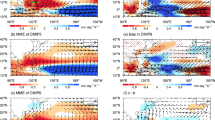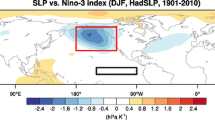Abstract
During the El Niño and La Niña mature phase, atmospheric teleconnections over the North Pacific and East Asia vary considerably on sub-seasonal time scales, and are strongly phase-locked to the sub-seasonal evolution. In this study, we investigate how well climate models that participated in the Coupled Model Intercomparison Project Phase 5 (CMIP5) simulate the sub-seasonal evolution of teleconnections over the North Pacific and East Asia associated with El Niño-Southern Oscillation (ENSO). In the observations, there is a prominent anticyclone anomaly over the Kuroshio extension region (i.e. Kuroshio anticyclone), which significantly affects East Asian climate in the early winter (November–December) of El Niño years. However, in January, the Kuroshio anticyclone suddenly disappears, and a cyclonic flow dominates over the North Pacific. It is found here that the CMIP5 models simulate the overall extratropical teleconnection patterns, but they fail to reproduce some of these sub-seasonally-varying features in atmospheric circulation. For example, the models tend to simulate a weaker Kuroshio anticyclone in the early winter during El Niño phases, and fail to capture the abrupt decay of the Kuroshio anticyclone in the late winter. We demonstrate here that these systematic errors in ENSO teleconnection can be explained by systematic errors in tropical precipitation associated with ENSO. That is, negative precipitation anomalies over the western North Pacific (WNP) are too weak in the models compared to that in the observations, and their amplitude tends to be strengthened from December to the following January, while they are weakened in the observations. In addition, analyses on the inter-model diversity strongly support that relative magnitudes of WNP and central Pacific precipitation anomalies are critical for determining sub-seasonal evolution of ENSO teleconnections over the North Pacific and East Asia.









Similar content being viewed by others
References
Ashok K, Behera SK, Rao SA, Weng H, Yamagata T (2007) El Niño Modoki and its possible teleconnection. J Geophys Res 112:C11007
Bjerknes J (1969) Atmospheric teleconnections from the equatorial Pacific. Mon Weather Rev 97:163–172
Blade I, Newman M, Alexander MA, Scott JD (2008) The late fall extratropical response to ENSO: sensitivity to coupling and convection in the tropical West Pacific. J Clim 21:6101–6118
Bulic IH, Brankovic C, Kucharski F (2012) Winter ENSO teleconnections in a warmer climate. Clim Dyn 38:1593–1613
Cai W et al (2015) ENSO and greenhouse warming. Nat Clim Change 5:849–859
Cha E-J, Jhun J-G, Chung H-S (1999) A study of characteristics of climate in South Korea for El Niño/La Niña years. J Korean Meteorol Soc 35:98–117 (in Korean with English abstract)
Gong H, Wang L, Chen W, Nath D, Huang G, Tao W (2015) Diverse influences of ENSO on the East Asian-western Pacific winter climate tied to different ENSO properties in CMIP5 models. J Clim 28:2187–2202
Ham Y-G, Kug J-S (2015) Improvement of ENSO simulation based on intermodel diversity. J Clim 28:998–1015
Held IM, Kang I-S (1987) Barotropic models of the extratropical response to El Niño. J Atmos Sci 44:3576–3586
Hoerling MP, Kumar A (1997) Why do North American climate anomalies differ from one El Niño event to another? Geophys Res Lett 24:1059–1062
Horel JD, Wallace JM (1981) Planetary scale atmospheric phenomena associated with the Southern Oscillation. Mon Weather Rev 125:773–788
Hoskins BJ, Karoly DJ (1981) The steady linear response of a spherical atmosphere to thermal and orographic forcing. J Atmos Sci 38:1179–1196
Hurrell JW (1995) Comparison of NCAR Community Climate Model (CCM) climates. Clim Dyn 11:25–50
Hurwitz MM, Calvo N, Garfinkel CI, Butler AH, Ineson S, Cagnazzo C, Manzini E, Pena-Ortiz C (2014) Extra-tropical atmospheric response to ENSO in the CMIP5 models. Clim Dyn 43:3367–3376
Kalnay E et al (1996) The NCEP/NCAR 40-year reanalysis project. Bull Am Meteorol Soc 77:437–471
Kang I-S (1998) Relationship between El Niño and climate variation over Korea peninsula. J Korean Meteorol Soc 34:390–396 (in Korean with English abstract)
Kim S, Kim H-S, Min S-K, Son H-Y, Won D-J, Jung H-S, Kug J-S (2015) Intra-winter atmospheric circulation changes over East Asia and North Pacific associated with ENSO in a seasonal prediction model. Asia-Pac J Atmos Sci 51:49–60
Kug J-S, Kang I-S (2006) Interactive feedback between the Indian Ocean and ENSO. J Clim 19:1784–1801
Kug J-S, Kirtman BP, Kang I-S (2006a) Interactive feedback between ENSO and the Indian Ocean in an Interactive Ensemble Coupled Model. J Clim 19:6371–6381
Kug J-S, Li T, An S-I, Kang I-S, Luo J-J, Masson S, Yamagata T (2006b) Role of the ENSO-Indian Ocean coupling on ENSO variability in a coupled GCM. Geophy Res Lett 33:L09710
Kug J-S, Ahn M-S, Sung M-K, Yeh S-W, Min H-S, Kim Y-H (2010a) Statistical relationship between two types of El Niño events and climate variation over the Korean Peninsula. Asia-Pac J Atmos Sci 46:467–474
Kug J-S, An S-I, Ham Y-G, Kang I-S (2010b) Changes in El Niño and La Niña teleconnections over North Pacific-America in the global warming simulations. Theor Appl Climatol 100:275–282
Kug J-S, Jin F-F, Park J-H, Ren H-L, Kang I-S (2010c) A general rule for synoptic-eddy feedback onto the low-frequency flow. Clim Dyn 35:1011–1026
Kug J-S, Ham Y-G, Lee J-Y, Jin F-F (2012) Improved simulation of two types of El Niño in CMIP5 models. Environ Res Lett 7:034002
Langenbrunner B, Neelin D (2013) Analyzing ENSO teleconnections in CMIP models as a measure of model fidelity in simulating precipitation. J Clim 26:4431–4446
Lau N-C, Nath MJ (1996) The role of the “Atmospheric Bridge” in linking tropical Pacific ENSO events to extratropical SST anomalies. J Clim 9:2036–2057
Livezey RE, Mo KC (1987) Tropical-extratropical teleconnections during the northern hemisphere winter. Part II: relationships between monthly mean northern hemisphere circulation patterns and proxies for tropical convection. Mon Weather Rev 115:3115–3132
Livezey RE, Masutani M, Leetmaa A, Rui H, Ji M, Kumar A (1997) Teleconnective response of the Pacific-North American region atmosphere to large central equatorial Pacific SST anomalies. J Clim 10:1787–1820
Meehl GA, Teng H (2007) Multi-model changes in El Niño teleconnections over North America in a future warmer climate. Clim Dyn 29:779–790
Min S-K, Son S-W, Seo K-H, Kug J-S, An S-I, Choi W-S, Jeong J-H, Kim B-M, Kim J-W, Kim Y-H, Lee J-Y, Lee M-I (2015) Changes in weather and climate extremes over Korea and possible causes: a review. Asia-Pac J Atmos Sci 51:103–121
Moron V, Gouirand I (2003) Seasonal modulation of the El Niño-Southern Oscillation relationship with sea level pressure anomalies over the North Atlantic in October-March 1873–1996. Int J Climatol 23:143–155
Muller WA, Roeckner E (2008) ENSO teleconnections in projections of future climate in ECHAM5/MPI-OM. Clim Dyn 31:533–549
Nitta T (1987) Convective activities in the tropical western Pacific and their impact on the Norther Hemisphere summer circulation. J Meteorol Soc Jpn 64:373–390
Oh JH, Shin DW, Cocke SE, Baigorria GA (2014) ENSO teleconnection pattern changes over the southeastern United States under a climate change scenario in CMIP5 models. Adv Meteorol 2014:648197
Power S, Haylock M, Colman R, Wang X (2006) The predictability of interdecadal changes in ENSO activity and ENSO teleconnections. J Clim 19:4755–4771
Ren H-L, Jin F-F, Kug J-S, Gao L (2011) Transformed eddy-PV flux and positive synoptic eddy feedback onto low-frequency flow. Clim Dyn 36:2357–2370
Smith TM, Reynolds RW, Peterson TC, Lawrimore J (2008) Improvements to NOAA’s historical merged land-ocean temperature analysis (1880–2006). J Clim 21:2283–2296
Son H-Y, Park J-Y, Kug J-S, Yoo J, Kim CH (2014) Winter precipitation variation over Korean Peninsula associated with ENSO. Clim Dyn 42:3171–3186
Sterl A, van Oldenborgh GJ, Hazeleger W, Burgers G (2007) On the robustness of ENSO teleconnections. Clim Dyn 29:469–485
Stevenson SL (2012) Significant changes to ENSO strength and impacts in the twenty-first century: results from CMIP5. Geophys Res Lett 39:L17703
Stuecker MF, Timmermann A, Jin F-F, McGregor S, Ren H-L (2013) A combination mode of the annual cycle and the El Niño/Southern Oscillation. Nat Geosci 6:540–544
Stuecker MF, Jin F-F, Timmermann A, McGregor S (2015) Combination model dynamics of the anomalous Northwest Pacific anticyclone. J Clim 28:1093–1111
Taylor KE, Stouffer RJ, Meehl GA (2012) An overview of CMIP5 and the experiment design. Bull Am Meteorol Soc 93:485–498
Trenberth KE, Branstator GW, Karoly D, Kumar A, Lau NC, Ropelewski C (1998) Progress during TOGA in understanding and modeling global teleconnections associated with tropical sea surface temperatures. J Geophys Res 103:14291–14324
Wallace JM, Gutzler DS (1981) Teleconnections in the geopotential height field during the Northern Hemisphere winter. Mon Weather Rev 109:784–812
Wang H, Fu R (2000) Winter monthly mean atmospheric anomalies over the North Pacific and North America associated with El Niño SSTs. Am Meteorol Soc 13:3435–3447
Wang B, Wu R, Fu X (2000) Pacific-East Asian teleconnection: how does ENSO affect East Asian climate? J Clim 13:1517–1536
Watanabe M, Jin F-F (2003) A moist linear baroclinic model: coupled dynamical-convective response to El Niño. J Clim 16:1121–1139
Watanabe M, Kimoto M (2000) On the persistence of decadal SST anomalies in the North Atlantic. J Clim 13:3017–3028
Weare BC (2013) El Niño teleconnections in CMIP5 models. Clim Dyn 41:2165–2177
Wu R, Hu ZZ, Kirtman BP (2003) Evolution of ENSO-related rainfall anomalies in East Asia. J Clim 16:3742–3758
Xie P, Arkin PA (1997) Global precipitation: a 17-year monthly analysis based on gauge observations, satellite estimates, and numerical model outputs. Bull Am Meteorol Soc 78:2539–2558
Xie S-P, Hu K, Hafner J, Tokinaga H, Du Y, Huang G, Sampe T (2009) Indian Ocean capacitor effect on Indo-Western Pacific climate during the summer following El Niño. J Clim 22:730–747
Yang W, DelSole T (2012) Systematic comparison of ENSO teleconnection patterns between models and observations. J Clim 25:425–446
Yeh S-W, Kug J-S, An S-I (2014) Recent progress on two types of El Niño: observations, dynamics, and future changes. Asia-Pac J Atmos Sci 50:69–81
Zhou T, Wu B, Dong L (2014a) Advances in research of ENSO changes and the associated impacts on Asian-Pacific climate. Asia-Pac J Atmos Sci 50:405–422
Zhou ZQ, Xie SP, Zheng XT, Liu Q, Wang H (2014b) Global warming-induced El Niño teleconnections over the North Pacific and North America. J Clim 27:9050–9064
Acknowledgments
This study was supported by the Korea Meteorological Administration Research and Development Program under Grant KMIPA 2015-2092.
Author information
Authors and Affiliations
Corresponding author
Rights and permissions
About this article
Cite this article
Kim, S., Son, HY. & Kug, JS. How well do climate models simulate atmospheric teleconnctions over the North Pacific and East Asia associated with ENSO?. Clim Dyn 48, 971–985 (2017). https://doi.org/10.1007/s00382-016-3121-8
Received:
Accepted:
Published:
Issue Date:
DOI: https://doi.org/10.1007/s00382-016-3121-8




